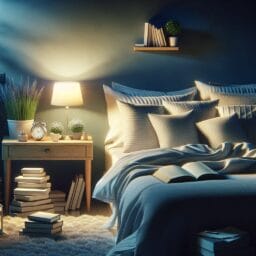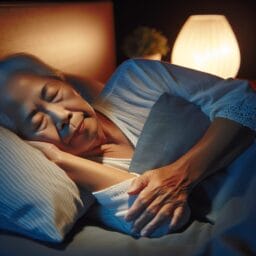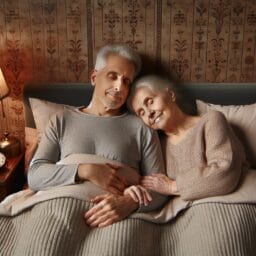
Maximizing Sleep Quality: Top Tips for Older Adults Embracing a Technology-Focused Lifestyle
Table of Contents
- Introduction
- Understanding Sleep Patterns in Older Adults
- The Role of Technology in Sleep Disruption
- Practical Tips for Maximizing Sleep Quality
- Leveraging Technology to Improve Sleep
- Addressing Sleep Disorders
- Conclusion
- Frequently Asked Questions
Introduction
Did you know that, as twilight tucks in the day, your body’s natural sleep cycle gears up for some rest? Yup, this magical nightly journey to dreamland is super important for older folks to feel chipper and ready to boogie. But sometimes, getting good zzz’s can be as tricky as trying to herd a bunch of cats! When screens from TVs and gadgets beam blue light at us, it tricks our brains into thinking it’s still party time when we should be winding down. This pesky glow can mess with sleep patterns and keep us counting sheep longer than we’d like.
Here’s a neat trick: Use dim red lights for nightlights since red light has less power to shift circadian rhythm and mess with sleep quality. It’s like setting the mood for a snooze-fest! And speaking of setting the mood, creating a cool cave-like bedroom environment helps big time. Turn that thermostat down so the bedroom temperature is just right for snuggling under the covers without feeling hot or cold.
Now let’s chit-chat about something super cool – no pun intended. Our core body temperature needs to dip a bit to invite Mr. Sandman over. So taking a warm bath before bed might seem odd, but it actually helps our bodies cool down afterward. Fancy that!
Snuggle-time should be free from buzzing phones too; reducing screen time an hour before bed can give your brain a break from electronic media exposure. Instead, try some lavender aromatherapy or listen to soft tunes that make your eyelids droopy.
Psst…let me spill the beans on another secret – sticking to a regular sleep schedule makes your body’s clock tick like a metronome, helping you fall asleep faster and stay asleep longer. If zany sleep schedules are making you tired during daytime adventures or cranky at your grandkid’s tea parties (oh dear!), chatting with a healthcare provider could help straighten things out.
Remember, every starry night offers a fresh chance for older adults to snag that good night’s sleep they deserve – all snug as bugs in rugs!

Understanding Sleep Patterns in Older Adults
Imagine a world where sleep is as delightful as a scoop of vanilla ice cream on a hot day. For older adults, getting that kind of good night’s sleep can be sweet indeed—but it’s not always a walk in the park. You see, as we age, our sleep architecture—that fancy term for the structure and sequence of our sleep stages—gets a makeover. Older peeps might notice they’re waking up more during the night or catching fewer of those deep zzz’s that make you feel like you’ve slept like a log.
Here’s the scoop: common sleep disorders like chronic insomnia and sleep apnea are party crashers for many golden agers. These uninvited guests can come from changes in health or simply because Father Time says so. But don’t worry; healthcare providers have a bag full of tricks to help manage these snooze spoilers. From CPAP machines that keep airways open to tips for tackling anxiety that keeps minds racing when they should be snoozing, there’s hope for reclaiming dreamland.
While we’re chatting about technology, did you know your gadgets could be sneaky thieves stealing those precious slumbers? Yep, those screens shoot out blue light, fooling your brain into thinking it’s daytime fun-time instead of sleepy-time. Older folks might find their circadian rhythm—the body’s natural clock—getting all out of whack with too much screen time late at night. It’s like trying to dance to music without a beat!
So let’s not forget about setting the stage for a stellar snooze-fest. The bedroom environment plays leading roles in this night show. A room that’s cooler than an igloo (well, almost) with just enough warmth to avoid shivers helps your core body temperature drop just right for dozing off. And hey, here’s another nugget: using blackout curtains blocks out bright light from street lamps or moonbeams that could nudge your eyelids open.
Lastly, winding down before bed isn’t old-fashioned—it’s gold-fashioned! Reducing screen time before bedtime gives way to improve relaxation practices like lavender aromatherapy or gentle stretches that whisper to every muscle ‘it’s time to relax.’ And remember—not oops—we won’t say “remember”—let’s stick to regular shut-eye schedules for peak sleep efficiency.
In short, older adults aiming for improved sleep quality amidst the buzzing digital age can still fetch some serious pillow time—with a little rewiring of habits and tweaking their nighttime nest! Sweet dreams await around each starry corner when one embraces these dreamy strategies!
The Role of Technology in Sleep Disruption
Picture this: older adults cozy in their beds, drifting off into a land of dreams where sleep is as sweet as a freshly-baked apple pie. But hold on! There’s a tiny gremlin lurking in the shadows, and it’s called blue light. This little rascal sneaks out of phones and tablets, whispering to your brain, “Hey there! It’s still daytime!” And just like that, melatonin production—the body’s snooze button—hits a snag.
Now let’s talk about our always-connected world that buzzes with notifications and rings with calls. Imagine trying to drift off while buzzes and pings keep you tethered to the waking world—it’s like trying to swim upstream against a current of distractions! Older adults might find themselves caught in this tide, struggling to find peace in the constant chatter of connectivity. This electronic symphony can play on loop all night if we’re not careful, stirring up trouble sleeping and inviting unwanted guests like sleep disturbances into our lives.
Tech gadgets are nifty for sure; they help us chat with grandkids or watch late-night shows from yesteryear. But here’s the kicker—they also throw our natural sleep-wake cycles for a loop-de-loop! Our built-in circadian rhythms get confused when bright screens mimic daylight at times when stars should be twinkling instead. To improve sleep quality amidst these modern marvels means setting boundaries—a tech curfew if you will—to give your body time to cruise down Sleepy Lane undisturbed.
So what’s an older adult to do? Strike back against these sleep-stealing culprits by crafting a bedroom haven—an oasis of calm where cool temperatures reign supreme and darkness envelopes the room, signaling it’s time for shut-eye. Think about slipping into sheets smoother than silk on skin or listening to sounds that mimic rain pitter-pattering on windows—nature’s lullaby!
By embracing such changes and consulting with a healthcare provider for pesky conditions like chronic insomnia or sleep apnea, achieving golden slumbers is more than just wishful thinking. With every night comes an opportunity for better rest, proving that even amongst tweets and tags, peaceful sleep isn’t just folklore—it’s well within reach!
Practical Tips for Maximizing Sleep Quality
Guess what? A sprinkle of old-school charm can help those in their golden years snuggle into dreamland just right. Tucking tech away from the bedroom an hour before bedtime isn’t about being out-of-touch; it’s about cradling your sleep quality like a precious gem. Think about this little nugget: Keeping gadgets outside the sleep sanctuary keeps pesky blue light and ping-ping notifications at bay, leaving room for nothing but sweet slumber.
Let’s paint a picture of the perfect snooze palace. The bedroom temperature is key—set it cool enough to make under-the-cover cuddles perfectly cozy. Use calming lavender aromatherapy, where gentle scents waft through the air like a warm hug, lulling you to relax every muscle fiber by fiber. And when it comes to lighting, opt for dim, warm bulbs that wave goodnight instead of the bright light that shouts “hello!”
Throughout your day-to-day activities, managing screen time is as important as picking comfortable shoes—not just comfy-cozy but super essential! Dive into hobbies that don’t involve glowing screens—maybe knitting or gardening? These are sure winners for keeping hands busy and minds calm, paving the way towards improving sleep efficiency when stars twinkle high above.
Here’s a nugget of wisdom: Setting strict tech-times during daylight hours reinforces healthy boundaries and helps prevent trouble sleeping due to overexposure to electronic media exposure. Regular breaks from screen-gazing not only give your eyes a rest but also train your brain to switch off and prepare for some serious zzz’s later. Psst…it might even boost how fast you nod off!
Consider consulting with a healthcare provider if you’ve got chronic conditions that might be stealing sandman’s spotlight. They’re like detectives finding clues on how to improve sleep quality amidst any health hurdles you might face—yes siree! And hey, while chronic insomnia may sound daunting as climbing Everest backwards, there are ways and means prescribed by pros that can tame that wild beast.
So let’s recap our recipe for success: cultivate an electronics-free bedroom environment; savor early-evening activities unplugged from digital worlds; keep regular tabs on daytime screen shenanigans; and create evening rituals soaked in tranquility—which could include anything from soothing tunes to reading pages of paperbacks (the kind with actual pages!).
Remember—you’ve got this! Every night is a fresh opportunity to hit the mark for better shut-eye. Let these tips be your guidebook towards embracing better nights filled with dreamy adventures in far-off lands (or maybe just counting sheep)—whatever floats your boat towards seas of serene sleep!
Leveraging Technology to Improve Sleep
Have you ever wondered how those smart bracelets and watches know when you’re snoozing? Well, get ready for some bedtime tech talk that’s cooler than the flip side of a pillow! Older adults can now use these nifty wearable gadgets to track their zzz’s. It’s like having a tiny sleep detective on your wrist, keeping an eye on your slumber shenanigans. These gizmos measure stuff like how much you toss and turn or how deep your sleep is, helping you understand your unique sleep patterns better.
Now let’s chat about apps that are like cozy bedtime stories for your brain. Meditation and relaxation apps serve up a buffet of chill-out tunes and guided meditations designed to escort you gently into dreamland. Picture this: lying in bed with soothing sounds of babbling brooks or whispers from wind chimes filling the room—pure magic for melting away the day’s hustle-bustle.
And it gets even more sci-fi cool! Wearable technology today isn’t just about counting steps—it’s becoming a game-changer in promoting sleep health among older adults. From buzzing you with gentle reminders to start winding down, to giving you virtual pats on the back for sticking to that gold-star sleep schedule, wearables are the new bedside besties.
To wrap things up in a snug blanket of know-how – here’s what’s hip in snooze city: little gadgets tracking night moves, apps spinning yarns of calmness into your ear, and all sorts of space-age wrist wizardry making sure seniors get that good night’s sleep they’ve been dreaming about. So if trouble sleeping has been knocking at your door, consider inviting some modern tech over for a slumber party—they might just be the ticket to catching those elusive forty winks!
| Type of Tech | Description | Benefits for Older Adults |
|---|---|---|
| Wearable Sleep Trackers | Devices like smart bracelets and watches that monitor sleep quality and patterns. | Helps in understanding and improving sleep habits by tracking movements and sleep depth. |
| Meditation and Relaxation Apps | Applications providing guided meditations, relaxing stories, and soothing sounds. | Aids in relaxation and falling asleep by creating a peaceful environment and reducing stress. |
| Advanced Wearable Technology | Wearables that offer reminders and positive reinforcement for maintaining good sleep practices. | Promotes sleep health by encouraging regular sleep routines and rewarding consistent behavior. |
Addressing Sleep Disorders
Hey there, sleepy heads! Did you know that sometimes our bodies need a little extra help to zoom off into dreamland? For older adults, this might mean saying howdy to some high-tech sleep aides if counting sheep just doesn’t cut it. Those fancy CPAP machines aren’t just for astronauts—they’re also for grandmas and grandpas who snore like a freight train or have trouble breathing easy at night. They work like a gentle breeze, keeping airways open so you can catch those z’s without a hitch.
But wait, there’s more! Advanced sleep support products are popping up like daisies in springtime. We’re talking mattresses that adjust to cradle your body just right and pillows that keep your neck happier than a clam at high tide. And yep, these aren’t your regular old feather-stuffed sacks. These smart pillows might even play lullabies or cool down your noggin to the perfect snooze temperature.
Now hold your horses—before you go on a wild shopping spree for all things sleep-tastic, have a chinwag with your healthcare provider. They’re like the wise owls of the sleeping forest, knowing all about which gizmos and gadgets could turn your nights from blah to ta-da! And if that bed of yours isn’t feeling quite heavenly, they’ll offer up advice tailored just for you.
So if tossing and turning is messing with your mojos or if catching those winks feels as elusive as a unicorn sighting, don’t be shy—ask the doc for some tips. A chat over tea or video call could set you on the path to improved relaxation and sweet dreams every night. Trust me; with the right professional guidance and maybe a sprinkle of tech wizardry, you’ll be sailing smoothly through slumberland before you can say “goodnight moon!”
Conclusion
Hey there, friends! Let’s gab about a hidden gem for snoozing soundly—a magical thing called your sleep environment. You see, where you saw logs matters heaps for shut-eye success. Think of your bedroom as a cozy den; it should be cooler than a cucumber and darker than a midnight sky to tell your body it’s time to hit the hay. And shush those gadgets that beep and glow—silence is golden when you’re aiming for those full eight hours of dreamy bliss. Now, don’t let sleep problems be the boss of you. If troubles are brewing, loop in a healthcare provider quicker than you can say “snore.” They’ve got smarty-pants tricks up their sleeves—from guiding you on how to keep your circadian rhythm jiving right, to tackling any pesky sleep disorders that might be lurking around. Remember (oops, I said remember), sipping some comforting chamomile tea or stretching out kinks with gentle yoga can kick relaxation into high gear before bedtime rolls around. Rocking a solid sleep schedule will help older adults catch those zzz’s smoother than butter on toast. So here’s to better nights ahead—may every evening lead to peaceful dreams and restful mornings!




